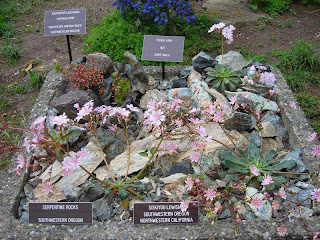On your last visit to the Carl English Garden at the Hiram Chittenden Locks, you might have noticed three rock planters in the courtyard beside the Visitor’s Center. I was curious about the plants there, as they didn't look like they were native to the Seattle area. Turns out, there’s a bit of history on display in those planters as well as several varieties of rock garden plants.
The person behind the rock garden planters is Stephen Munro, a gardener who works for the Corps of Engineers at the Ballard Locks. Stephen says that “The genesis of the planters began with my desire to have on display Claytonia megarhiza var. nivalis, which was discovered by Mr. Carl English Jr.” Although the plant was discovered by Carl English, it was not currently in the garden’s collection.
Stephen had first attempted to start the plant from seed collected in the Wenatchee Mountains. But unfortunately none of the seeds proved viable. Then Stephen made contact with the Northwestern Chapter of the North American Rock Garden Society, in which Carl English was active. A member of that organization, a recognized worldwide expert in the cultivation of alpine plants (who wishes to remain anonymous), was most generous. He donated three samples of Claytonia, but also Lewisia Columbiana var. rupicola “Saddle Mountain” variety (another discovery of Carl English), and other plants native to the Wenatchee Mountains.
These specialized plants grow mainly under certain geologic conditions in certain locations. In fact, the presence of these plants is a key indicator of specific geologic events. To grow them, Stephen had to attempt to recreate the soil and climate conditions in which they are found. Stephen says, “The planter attempts to reflect the natural habitat of Mount Stuart with two large granite boulders in the middle with serpentine rocks encircling the sides. There are some plants native to the Wenatchee Mountains thrown in as well.”
Mr. English recognized the unique specialization of these plants. In fact, he believed that Lewisia Columbiana var rupicola should be its own species, Lewisia rupicola. He based this on the evidence that when the variety rupicola is crossed with columbiana the progeny does not produce seed. English was overruled by other botanists, but many agree with him to this day.
As you might have already deduced, each plant at the Carl English Jr. Botanical Garden has several stories to tell. There is a horticultural story of course, and often, there is a historical tidbit as well. Our thanks go out to Stephen Munro for telling us the stories behind the rock garden planters.



No comments:
Post a Comment
add any information here